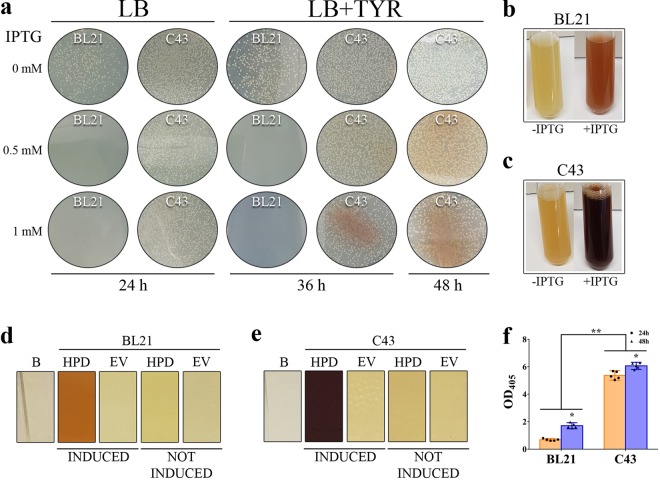Figure 2.
(a) On LBKANA-agar plates with IPTG induction (0.5 mM or 1 mM), growth of E. coli BL21 gold (DE3), expressing human HPD, was absent whereas BL21 gold (DE3) EV control plates showed normal bacterial growth (not shown). This indicates the toxicity of the HPD protein for this strain. This is not the case for C43 (DE3) for which growth and expression is unaffected even when higher concentrations of IPTG were used. Pyomelanin production was detected in the C43 (DE3) LBKANA-agar plates after induction, which confirms successful expression of active recombinant human HPD enzyme by C43 (DE3) E. coli. (b–e) LBKANA liquid medium was inoculated with C43 (DE3) or BL21 gold (DE3), uninduced or induced with 1 mM IPTG, supplemented with 0.75 mg/mL TYR, to compare protein expression and activity in liquid cultures. E. coli BL21 gold (DE3) and C43 (DE3) liquid cultures clearly showed the production of pyomelanin pigment 24 h after induction, whereas this was not the case for the empty vector and not induced control cultures. (f) Quantitative measurement 24 hours after induction shows that pyomelanin production by BL21 gold (DE3), expressing human HPD, lead to an OD405 of 0.688 ± 0.074, whereas C43 (DE3) achieved significantly higher pyomelanin levels as shown by an OD405 of 5.370 ± 0.281. This resulted in a 7.8-fold higher OD405 for C43 (DE3) compared to BL21 gold (DE3). 48 hours after induction, OD405 for C43 (DE3) was 6.064 ± 0.209 and reached 1.708 ± 0.178 for BL21 gold (DE3) which is still 3.5-fold lower compared to C43 (DE3).

